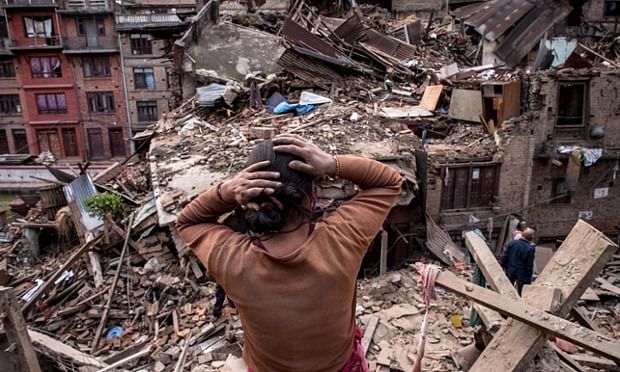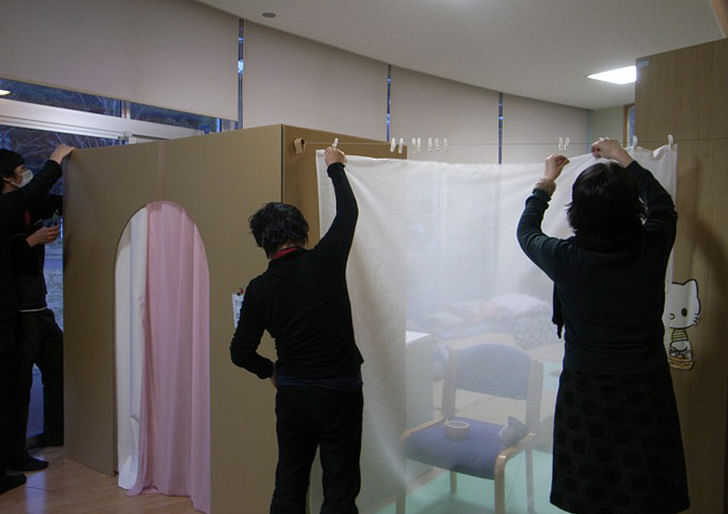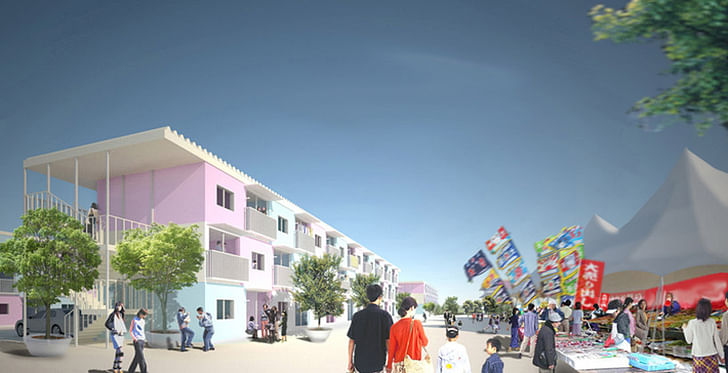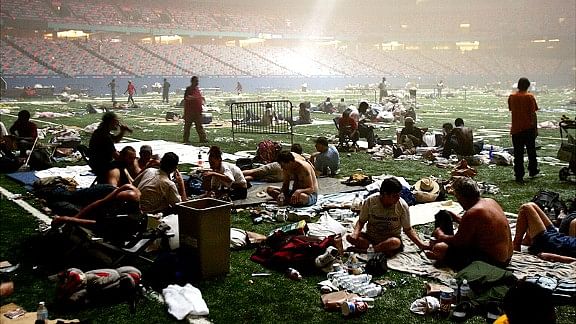

April 25th’s 7.8 magnitude earthquake in Nepal has razed entire villages, severely disrupted basic infrastructure, and is responsible for the loss of over 5,000 lives. According to The Guardian, the death toll may rise to as many 10,000 people. Unfortunately, in the wake of natural disasters, the architectural community has traditionally waited out the initial emergency phase before lending aid. The embarrassing response to 2005’s Hurricane Katrina in New Orleans, in which thousands of refugees sweltered in the Superdome for days without ready access to running water, prompted organizations including the AIA to revamp their emergency-response guidelines. Now, architects are encouraged to immediately respond to a disaster.
Generally speaking, there are three distinct phases in a natural disaster: Emergency, defined as the three-week period immediately following the disaster; Relief, the six-month phase encompassing the construction of short-term housing; and Recovery, which involves long-term planning and rebuilding, and can last for three years or more. Instead of waiting to react, here are concrete (and often wood, textile, and inflatable) examples of how architects can take helpful action in each phase of the Nepal crisis.
Emergency
In the emergency phase, architects can help primarily by fundraising or donating money (a list of donation collecting agencies for Nepal whose accountability practices have been vetted by the Better Business Bureau can be found here). At this time, Nepalese officials are still trying to get in touch with several remote villages which aerial surveys reveal were flattened by the earthquake. Donations to relief agencies are crucial at this stage to help rescue people who may still be trapped beneath debris and contact others who are displaced. However, for those architects who are unharmed and within close geographical range of a disaster, creative ingenuity can be beneficial. Shortly after the March 2011 tsunami in Japan, textile designer Yoko Ando made curtains that provided inexpensive, easily installed privacy partitions to those housed in emergency shelters, helping to improve the displaced’s quality of life.

Relief
The design and construction of short-term housing, as well as the inspection of existing historical structures, follows the initial emergency phase. Architects can lend support by designing easily constructed, affordable short-term housing. This can be both a sustainable and inventive endeavor: After the 2011 tsunami, Shigeru Ban Architects designed temporary housing for displaced citizens made from shipping containers. For his part, Arata Isozaki teamed with Anish Kapoor to create a 500-seat inflatable amphitheater that could tour affected regions, providing a forum for concerts and performances.

Recovery
The much-lauded and now unfortunately shuttered organization Architecture for Humanity helped Haitians plan and rebuild following that country’s 2010 7.0 magnitude earthquake. Architecture for Humanity’s principal contribution was setting up a Rebuilding Center, which served as a hub for consultations between designers, builders, contractors, and those seeking professional training. By creating a gathering place for outside experts and local community members, Architecture for Humanity managed to foster a self-sustaining organization that could build much needed local facilities like schools, hospitals, and permanent housing.Taking no action is the same as making an 'architectural no comment'

Whether donating much needed funds, designing short-term housing, or planning a new urban center, architects are of invaluable aid to their global community during a disaster. In 2005, many New Orleans residents survived the actual hurricane and subsequent flooding, but did not survive the messy and protracted evacuation. In a disaster, taking no action is the same as making an "architectural no comment." Much of Nepal's rich cultural history has been destroyed; if we take action now, the architectural community can contribute much more than a meaningful statement.
Julia Ingalls is primarily an essayist. Her work has appeared or is forthcoming in Slate, Salon, Dwell, Guernica, The LA Weekly, The Nervous Breakdown, Forth, Trop, and 89.9 KCRW. She's into it.
8 Comments
Thanks for writing this. It is great that you are bringing it up and framing it the way you have.
After the tsunami in Tohoku Japan a few friends started the AFH chapter in Tokyo and learned how difficult it is to act. Its still important. Essential even. The trick is to still be there and still be engaged 2 years or 4 years or 5 years later, when communities are finally ready to build. The first months are about survival. Architects can help but need to be careful not to just be in the way (a lot of getting in the way happens). Communities get burned out on well-meaning architects and students conducting studios too. After a few years they decide we are basically not really serious and it becomes ever more difficult to engage with them as architects. My feeling is that it is exactly at that time we are most needed. In Tohoku thousands are still living in the temporary housing set up right after the disaster. They were never well planned to begin with, and like the FEMA trailers of NO fame, not exactly livable.
The trouble is that the folks who had the means to leave have done so, and now its really the people who cannot afford it that are still struggling. Economies have been hobbled, communities torn apart, infrastructure left un-restored. Now is really the time for architects to act, to help build a sustainable community. But we blew our wad on sexy stuff in the early days, and anyway the news cycle has long since moved on. There is not much money time or interest left over, which is where it becomes a real challenge.
AFH has always been about building for the long term recovery. That is what sets it apart. What makes it most difficult is that it is hard to raise funds for the longterm approach that the concept really needs. We will all talk about Nepal for a while, and it will come up on the anniversaries for sure, but if action is important now it is also important years from now. We are not so good at that last part still. Funding is always about the splashy short term, with deadlines and reports with important benchmarks and cool outcomes (preferably with photo ops). Those are all great. They have an impact, absolutely. The thing that would be most amazing and awesome to see is architects with the support network in place to carry on until the job was properly done.
In Japan we can connect with social entrepreneurs (maybe), and at the very least the country is wealthy enough that I can imagine solutions emerging at some point. Nepal is much more worrying. It will find ways to cope I am sure, but what would be truly amazing if it came out of this better off. I would be quite proud to hear architects getting behind that idea as a matter of course. I think that is the true test for us as a community.
For what it is worth, regarding AFH, the HQ is shuttered, as you say, but the chapters are still working. There is an ongoing discussion amongst the members about how to react to the disaster in Nepal and I expect in some form or another AFH will be involved there. Cameron's legacy may not be what he imagined it might have been but it is still impressive.
Thanks, Will! I appreciate the background on AFH and its continued operating chapters, and your emphasis on remaining committed to the long-term recovery efforts. Nepal obviously poses a vastly different challenge than Japan, both economically and topographically, but I agree: it would be amazing if, by architectural communal might, Nepal came out of this with better planning/infrastructure/etc.
"How Architects Can Help Nepal"...donate much needed funds, design short-term housing, or planning a new urban center. All noble things, but I would think of the long term as re-building what from all the images I've seen was an incredibly beautiful city.
I hope architects don't come in and give them their versions of what is local with out doing something that actually feels local. There are physical needs and there are emotional needs. Once the physical ones are settled, I hope architects have the humility to shelve their design agendas and help to re-build in a way that gives the people a sense of continuity so the post-earthquake life is connected to the pre-earthquake life and not just about recycled shipping containers.
Excellent post, Will. Thank you for weighing in with that close-up experience.
How not to rebuild Nepal: Lessons from Haiti five years after its earthquake
Great article. I appreciate your insight and point of view on the situation.
You've hit home on a disaster that is so far away for many of us. I'm anxious to see what our community can do to help them rebuild and recover.
Dear Architects,
It is obvious that shrines, historical monuments AND HOUSES in Nepal should be rebuilt. But, for Goodness sake, please rebuild them in safe, shock-resistant way! Not from bricks.
Please, inform opinion about this demand. I'm not architect, nor am I rich man. But people can help, if organization and INFORMATION is sufficient. Act on Facebook, everywhere! Thank you for all,
Christopher
Hi Julia,
I'm originally from Nepal currently living in New York. I was really glad to read your post with your concerns about Nepal. It shows not just Nepalese but there are people around the globe who care about Nepal. I am doing a research paper for my Humanities course, and I came across your post while I was doing my research.
Nepal is well known for her cultural heritage, temples, and typical houses and I thought we should rebuild without destroying the old concept. But after reading the discussion threads, I thought there is no harm in changing. People resist change and so they would not progress. Emotional values are one thing but you gotta think practically when it is about people's lives. Maybe we can build similar structures but use different materials that are not gonna cost many lives even during massive disasters like the earthquake in 2015.
Block this user
Are you sure you want to block this user and hide all related comments throughout the site?
Archinect
This is your first comment on Archinect. Your comment will be visible once approved.